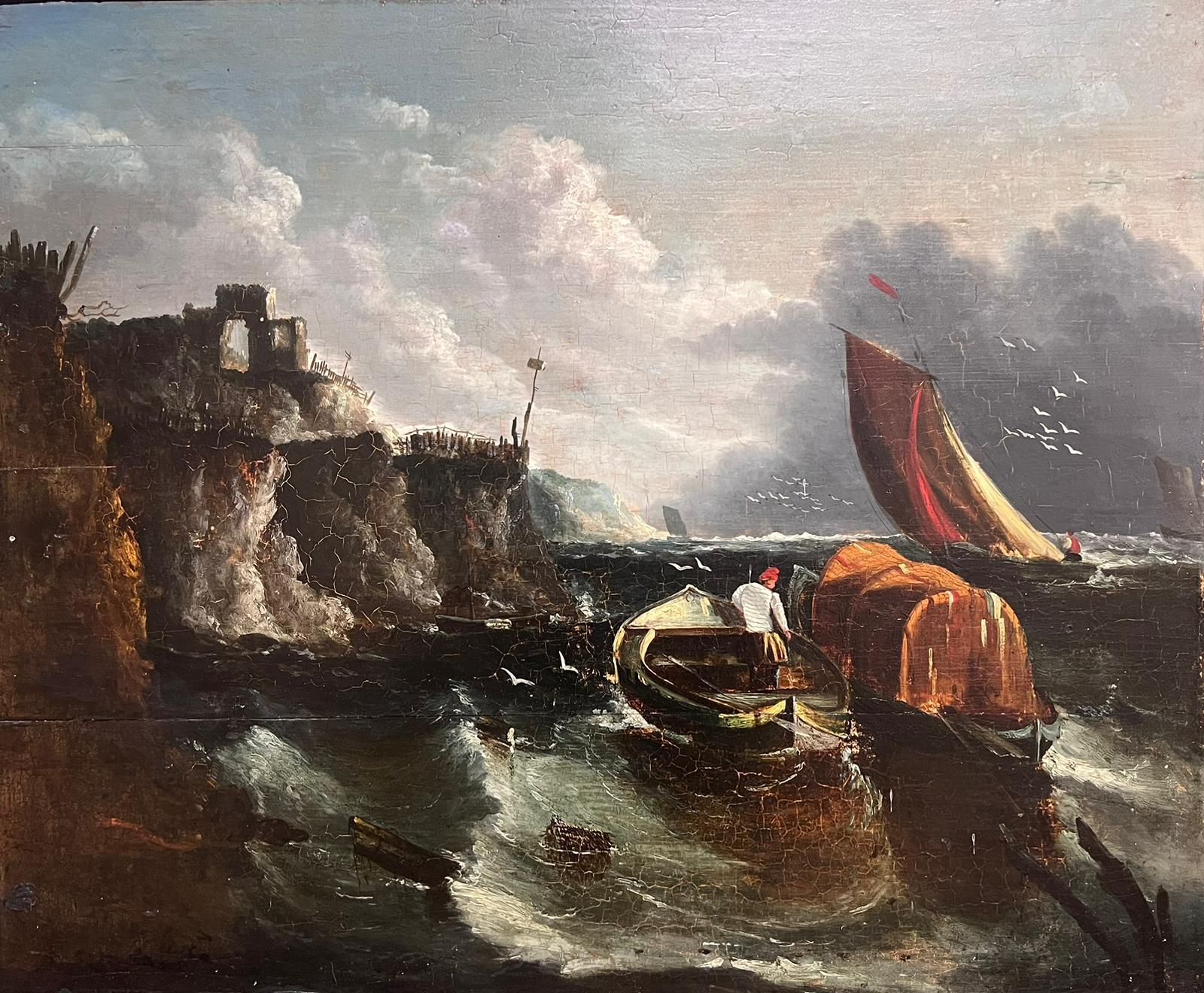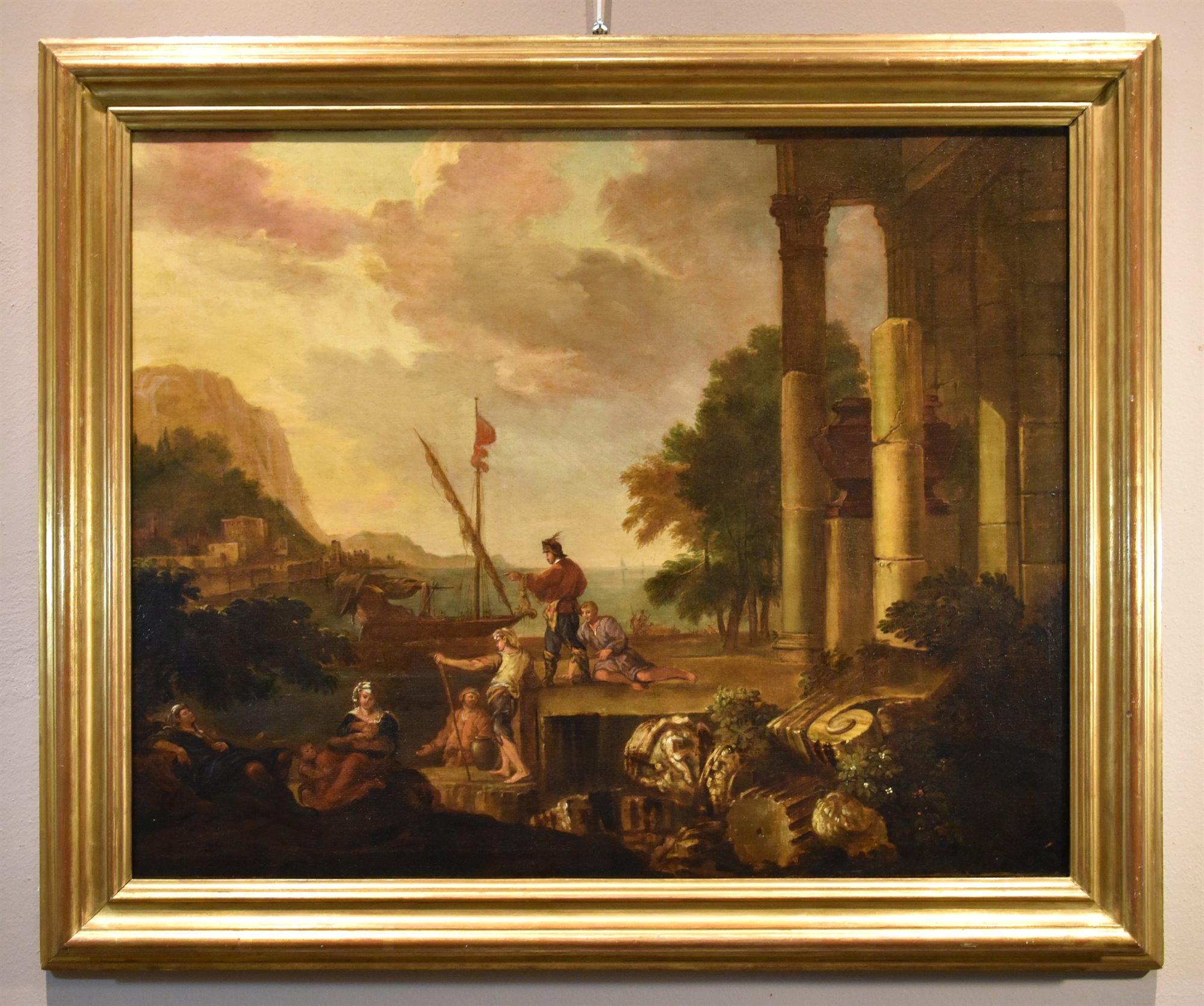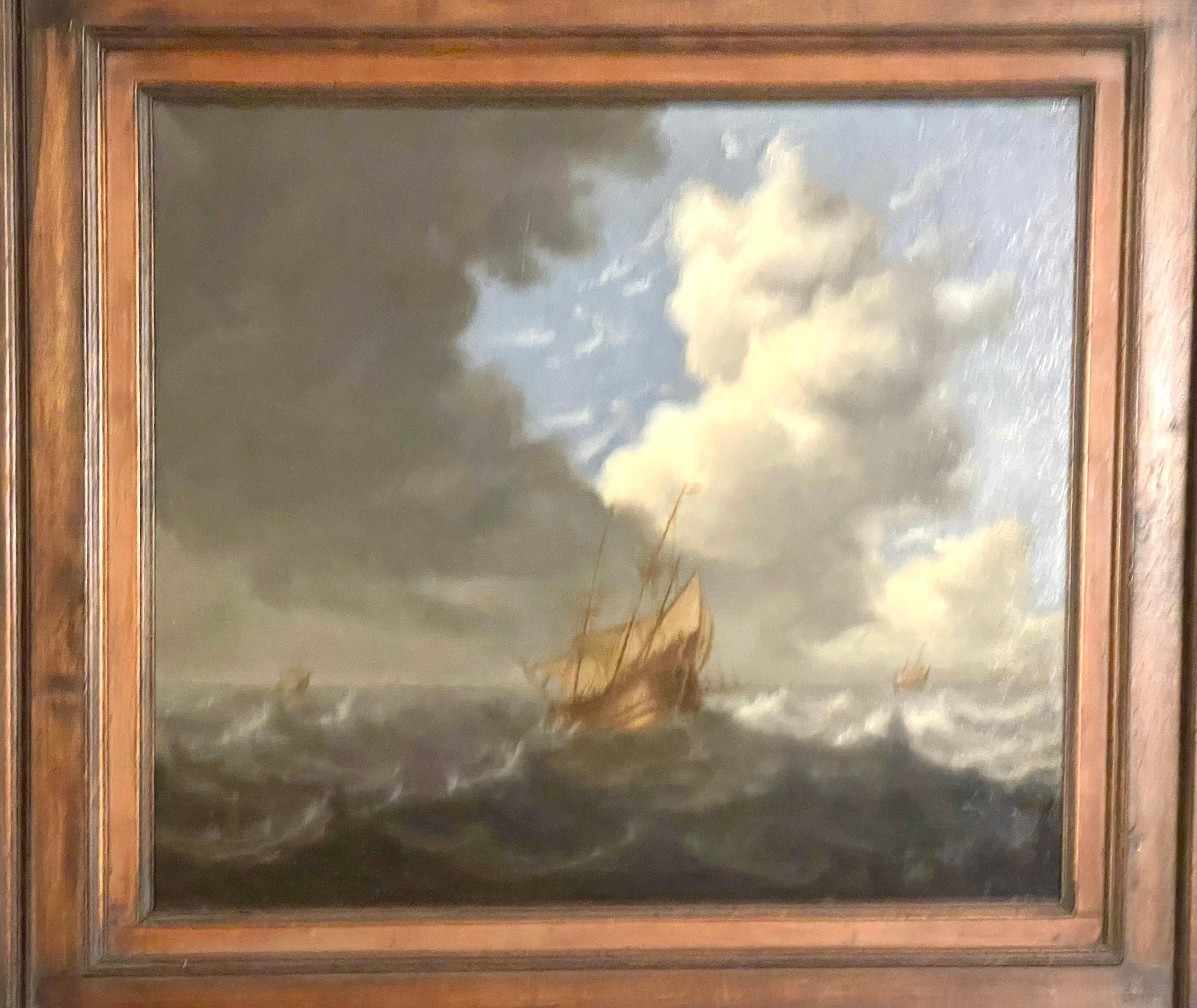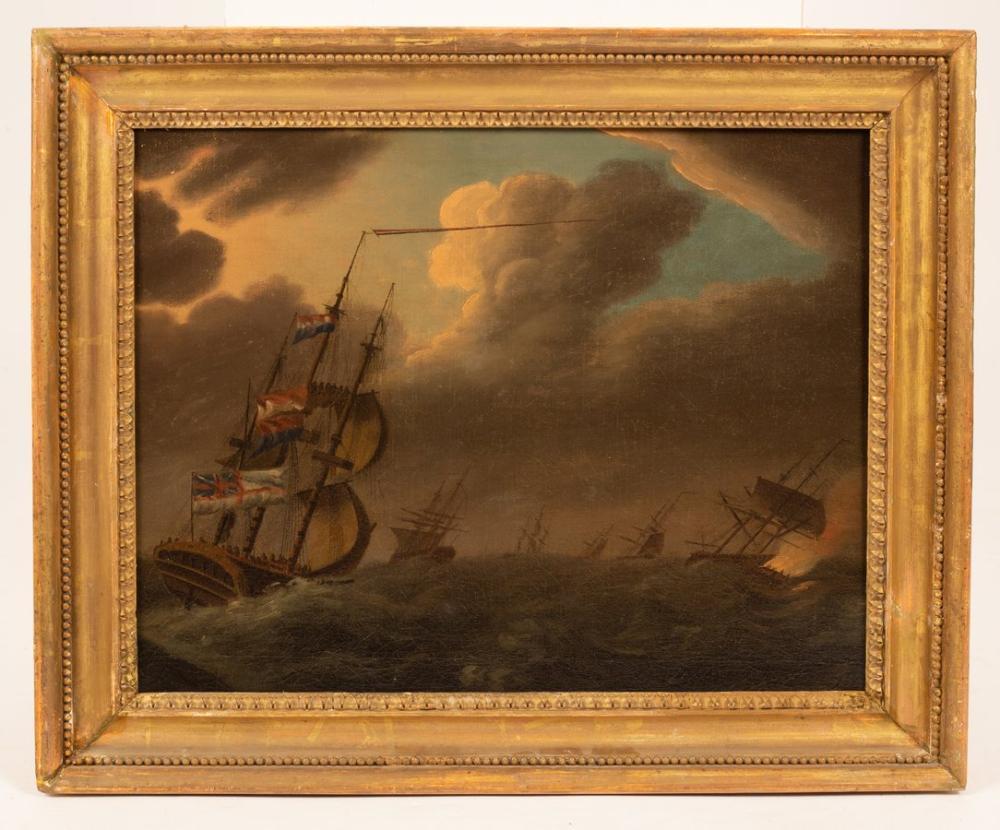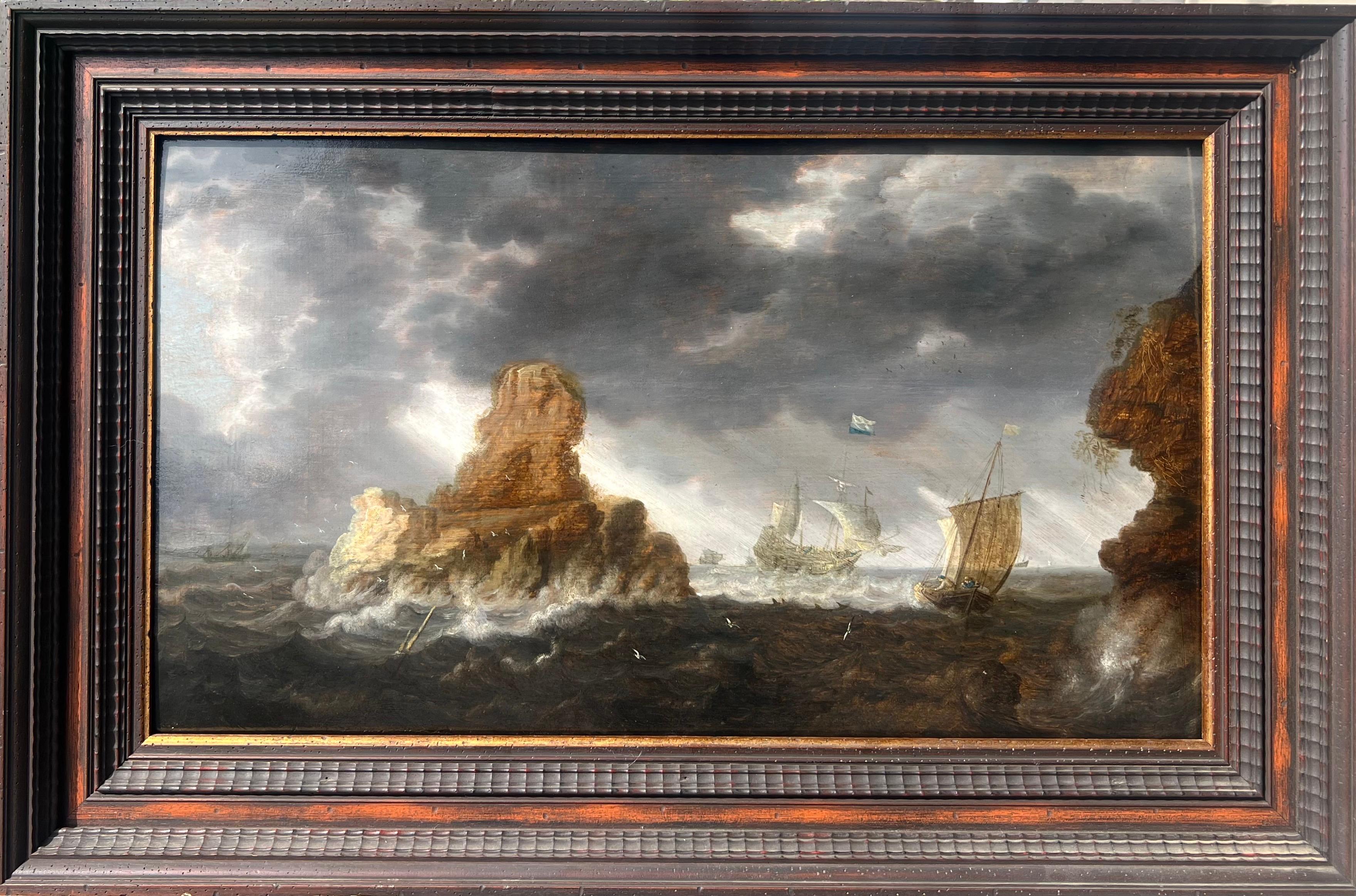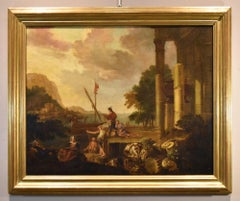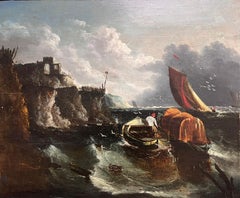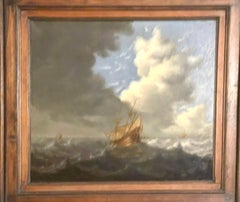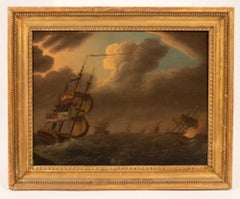Items Similar to Seascape Ships Landscape Porcellis 17th Century Paint Oil on table Old master
Want more images or videos?
Request additional images or videos from the seller
1 of 16
Seascape Ships Landscape Porcellis 17th Century Paint Oil on table Old master1630-1645
1630-1645
$8,477.56
$10,596.9520% Off
£6,297.64
£7,872.0520% Off
€7,072
€8,84020% Off
CA$11,772.07
CA$14,715.0920% Off
A$12,846.06
A$16,057.5820% Off
CHF 6,737.98
CHF 8,422.4720% Off
MX$156,019.69
MX$195,024.6120% Off
NOK 84,161.01
NOK 105,201.2620% Off
SEK 79,536.36
SEK 99,420.4620% Off
DKK 53,838.39
DKK 67,297.9920% Off
About the Item
Julius Porcellis (Rotterdam 1610 – 1645 Leiden) attributable
Seascape with ships
Oil on wood panel (oak) 52 x 84 cm In gilded wood frame 77 x 108 cm
The painting on display depicts an evocative seascape in stormy weather: the rough sea crashes against a rocky cliff while several boats, including a small fishing boat near the shore and a merchant ship offshore, try to continue on their course despite the weather conditions.
A typical subject of Baroque painting, the fury of the sea was a very popular theme, especially in 17th-century Dutch art, capable of representing the power of nature in a dynamic, exciting and dramatic way.
The resistance of the ships against the waves, where we can imagine the crew struggling to maintain control, was intended as a metaphor for life, indicating a close but vulnerable interrelationship with the forces of nature, often in contrast with the fragility of man.
The work's painting style and composition clearly reference the hand of Julius Porcellis (Rotterdam 1610 – Leiden 1645), a painter of the Dutch Golden Age specialising in seascapes and son of Jan Porcellis (1584–1632), from whom he was trained and under whose influence he remained throughout his life.
Even during the 17th and 18th centuries, art connoisseurs found it difficult to distinguish between the work of the father and that of the son. As can be seen in many of his seascapes, Porcellis depicted the stormy sea breaking against a high rock formation.
The three-masted ship in the distance, known as a pinnacle, with its sails lowered to protect it from the stormy winds, is also one of his signature features.
Our view is typical of the master, with his classic compositional style that made him highly regarded at home and abroad, promoting a new style and subject in marine painting by focusing on cloudy skies and rough waters.
Porcellis' contribution to Dutch art also lies in his emphasis on the effects of light: the composition is enveloped in a strong luminosity, with a cloud-filled sky from which flashes of light spread out, reverberating on the water and illuminating the foaming waves, highlighting the three-dimensionality of the painting.
ADDITIONAL INFORMATION:
The painting is sold complete with a nice frame and comes with a certificate of authenticity and a descriptive iconographic card.
We take care of and organise the transport of purchased works, both in Italy and abroad, through professional and insured carriers.
If you would like to see this or other works in person, we would be delighted to welcome you to our new gallery in Riva del Garda, at Viale Giuseppe Canella 18. We look forward to seeing you!
Please contact us for any information or to arrange a visit, we will be happy to assist you.
- Attributed to:Julius Porcellis (rotterdam 1610 – 1645 Leiden)
- Creation Year:1630-1645
- Dimensions:Height: 30.32 in (77 cm)Width: 42.52 in (108 cm)
- Medium:
- Movement & Style:
- Period:
- Condition:
- Gallery Location:Riva del Garda, IT
- Reference Number:1stDibs: LU988116510522
About the Seller
4.9
Platinum Seller
Premium sellers with a 4.7+ rating and 24-hour response times
Established in 2017
1stDibs seller since 2018
260 sales on 1stDibs
Typical response time: <1 hour
- ShippingRetrieving quote...Shipping from: Riva del Garda, Italy
- Return Policy
Authenticity Guarantee
In the unlikely event there’s an issue with an item’s authenticity, contact us within 1 year for a full refund. DetailsMoney-Back Guarantee
If your item is not as described, is damaged in transit, or does not arrive, contact us within 7 days for a full refund. Details24-Hour Cancellation
You have a 24-hour grace period in which to reconsider your purchase, with no questions asked.Vetted Professional Sellers
Our world-class sellers must adhere to strict standards for service and quality, maintaining the integrity of our listings.Price-Match Guarantee
If you find that a seller listed the same item for a lower price elsewhere, we’ll match it.Trusted Global Delivery
Our best-in-class carrier network provides specialized shipping options worldwide, including custom delivery.More From This Seller
View AllCoastal Landscape De Heusc Paint 17th Century Oil on canvas Old master
Located in Riva del Garda, IT
Jacob de Heush (Utrecht 1657 – Amsterdam 1701)
Coastal landscape with architectural ruins
Oil on canvas (80 x 102 cm - In frame 100 x 119 cm)
Provenance: Hampel Munich, 22.09.2...
Category
17th Century Old Masters Paintings
Materials
Oil
$9,848 Sale Price
20% Off
Landscape Marina Van Der Velde Old master 17th Century Signed Flemish Paint
Located in Riva del Garda, IT
Quality work attributed to the painter Peter Van Der Velde (Antwerp 1634 - c.1714) - Monogrammed
Coastal view with vessels and perched castle
Oil painti...
Category
17th Century Old Masters Paintings
Materials
Oil
$14,744 Sale Price
35% Off
Coastal Landscape See Paint Lacroix de Marseille Oil on canvas 18th Century Art
Located in Riva del Garda, IT
Coastal view at sunset with fishermen and boats
Atelier of Charles François Grenier De Lacroix, called de Marseille (Marseille 1700 - Berlin 1782)
Oil on canvas
50 x 62 cm. - in fra...
Category
18th Century Old Masters Paintings
Materials
Oil
$7,355 Sale Price
20% Off
See Landscape Night Naval Battle Mercanti 17/18th Century Paint Oil on copper
Located in Riva del Garda, IT
Ilario Mercanti, known as ‘lo Spolverini’ (Parma, 1657 - 1734)
Scene of a night-time naval battle
oil on copper (oval) 59 x 74 cm - with frame 83...
Category
17th Century Old Masters Paintings
Materials
Oil
$7,383 Sale Price
20% Off
Landscape Marina See Van Der Velde Paint Oil on canvas Old master 17th Century
Located in Riva del Garda, IT
Quality work attributed to the painter Peter Van Der Velde (Antwerp 1634 - c.1714)
Coastal view with fortified city and boats (city of Antwerp?)
Oil pa...
Category
17th Century Old Masters Paintings
Materials
Oil
$12,201 Sale Price
35% Off
Landscape See Paint Oil on canvas Flemish Old master 18th Century Italian Art
Located in Riva del Garda, IT
Flemish painter active in Italy in the eighteenth century
Coastal landscape of the Mediterranean with architectures and figures
Oil painting on canvas (69 x 88 cm., in frame 80 x 100 cm.)
The suggestive view proposed depicts a coastal view with a bay and the ruins of an ancient building, probably a monastery or a church, and in the background another building with a garden surrounded by high walls close to the shore.
The type of landscape, typical of the southern Italian environment, and the intimate atmosphere that welcomes the scene, attributes the authorship of the work to a landscape painter active in the eighteenth century, presumably in Italy in this period, with immediate references to the Dutch school , and in particular to the production of Jacob de Heusch and above all of Gaspar van Wittel, considered the progenitor of Italian landscape painting.
In fact, in the rendering of the architectural details, in the purity with which the buildings have been reconstructed, as well as in the atmosphere that encompasses the entire landscape, a marked correspondence to the so-called "Vanvitellian realism" can be seen: in fact, a comparison with a certain series of views which the Dutchman...
Category
18th Century Old Masters Paintings
Materials
Oil
$7,133 Sale Price
20% Off
You May Also Like
18th Century English Marine Oil Painting on Wood Panel Fishing Boats Stormy Sea
Located in Cirencester, Gloucestershire
Stormy Seas
English School, 18th century
oil on thick wood panel, unframed
panel: 25 x 30 inches
provenance: private collection, East Anglia, England
condition: very good and sound c...
Category
18th Century Old Masters Landscape Paintings
Materials
Oil
Large 18th Century Oil Painting Marine Seascape of British Navy Fleet off Dover
By Dominic Serres
Located in Gerrards Cross, GB
‘The British Fleet with a Vice-Admiral of the Red off Dover’ by Dominic Serres R.A. (1722-1793).
French-born Dominic Serres didn’t just paint the drama of...
Category
Late 18th Century English School Landscape Paintings
Materials
Oil
$26,730 Sale Price
35% Off
Dutch ships on rough seas 17th Century
Located in Hillsborough, NC
Dutch School, 17th century oil painting on board, this work features a golden ship on blue seas with white crests against a stormy clouded sky. In the distance more ships can be seen, and a spot of blue sky gives the stormy clouds relief. Light shines through the white clouds casting shadows of color on the gray storm and choppy sea waters. Dramatic and masterful.
Presented in overall very good condition in what may be the original mahogany wood frame.
Excellent for an office, library, den or study, but can also be effective in a living room, dining room or bedroom.
The frame has a rich wood tone. Easy to ship and ready to hang.
Check out our Saltire Gallerie...
Category
17th Century Dutch School Landscape Paintings
Materials
Oil, Board
$2,560 Sale Price
20% Off
Fine 18th Century British Marine Oil Painting Naval Shipping in Stormy Seas
By Charles Brooking
Located in Cirencester, Gloucestershire
Naval Shipping in Stormy Seas
English School, 18th century
circle of Charles Brooking, (1723-1759)
oil painting on canvas: 16.5 x 21.5 inches
Morland ...
Category
18th Century Old Masters Landscape Paintings
Materials
Canvas, Oil
$3,240 Sale Price
20% Off
17th century Flemish seascape - Stormy Sea with Merchant Vessels and dolphins
By Bonaventura Peeters the Elder
Located in Aartselaar, BE
Bonaventura Peeters the Elder (1614–1652) attr., Stormy Coastal Scene with Merchant Vessels, Galliot, and Dolphins
Framed by rugged cliffs and illuminated under a dark, swirling sk...
Category
17th Century Old Masters Landscape Paintings
Materials
Oil, Panel
17th century Flemish seascape - Ships in a mediterranean harbour - seascape
Located in Aartselaar, BE
Where the Sea Meets Home, A 17th-Century Port Seascape attributed to Andries van Eertvelt
Bathed in the warm and vibrant light of a beautiful day, this remarkable 17th-century seasc...
Category
17th Century Old Masters Landscape Paintings
Materials
Oil, Panel
More Ways To Browse
Father Son
Oil Painting Ships At Sea
17th And 18th Century Oil Paintings
17th Century Dutch Landscape Paintings
Old Master Oil On Wood Panel
Italian Oil Painting Old Man
18th Century Dutch Oil Paintings
Antique Ship Paintings
Paintings Of Old Man And The Sea
17th Century Oil Landscapes
Ship Oil Painting Framed
18th Century Oil Paintings Of Ships
Merchant Ship
The Furies
Antique Ships Table
Antique View Master
Oil Ship Seascape
Old Master Seascape
